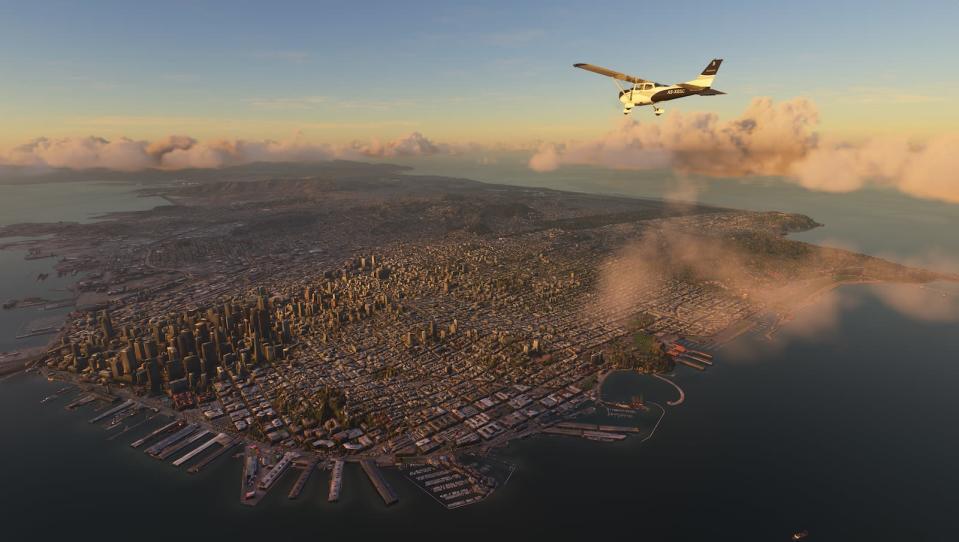All I want to do is chill and play 'Flight Simulator'
Microsoft's latest title turns the planet into a living playground.
It's been a long day. You get home as the sun is setting and close the door behind you, throwing down your keys and sliding off your shoes. You grab a drink and sink into the chair in front of your PC. The screen boots up and -- click, click -- it's filled by a long stretch of asphalt backed up by the mechanical hum of a single-engine Cessna. You throttle the small plane forward, straighten out, and take off. As soon as you're in the air, you flip the perspective from inside the cockpit, surrounded by dials and gauges and window frames, to a third-person view just behind the plane. Suddenly, the land below stretches 600km in every direction, alive and dense with realistic detail. Above, an infinite sky is peppered with layers of mist and clouds. You pick a direction and fly.
It feels like Flight Simulator was made for exactly this scenario: coming down after a long day. But, after soaring around a digital Earth for four hours, casually exploring exotic and familiar locations, it's clear that the game offers plenty more than mere relaxation -- though developers at Microsoft and Asobo Studio would recoil at the term "game." Flight Simulator is too deeply researched and technically detailed to be anything less than a full-on simulation experience, in their eyes. And, even in pre-alpha, that seems to ring true.
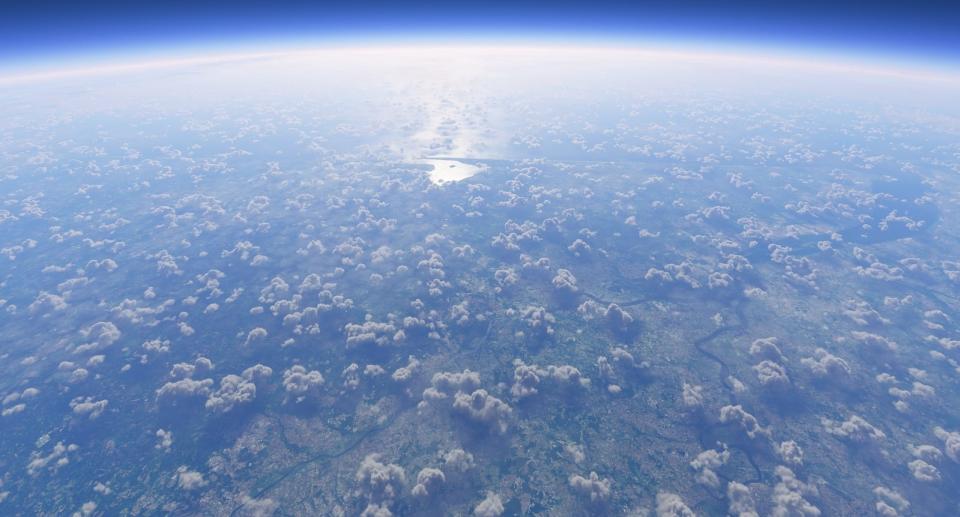
Hands-on with Flight Sim
The first location I loaded up was Phoenix, Arizona, my hometown. I wanted to see if the map in Flight Simulator would be accurate enough for me to recognize landmarks, follow highways and even spot specific houses. Besides, Phoenix is gorgeous, especially at sunset -- the airport sits at the heart of a desert valley, saguaros and skyscrapers highlighted from the west in brilliant purples and reds.
I flew over my former condo complex.
Not only did I recognize the airport immediately, but also every side street, skyscraper and mountain range that came into view. Keeping my tiny plane aloft, I clicked through the settings menu at the top of the screen, and shifted the weather and time of day, making the sun and stars streak across the sky. I chose scattered clouds, just as the fading light turned golden. I clicked back and continued flying, tapping the rudder and shifting the wings gently to one side, aiming for the row of high-rises marking downtown. The engine whirred and I pulled the nose of the plane upward, compensating for power lost in the turn.
Each prominent building was accurate and in the correct location, including unique architectural details, company logos and store names. I flew over my former condo complex and saw the exact balcony where I would sit and listen to podcasts while watching the city lights flicker on; I soared over Central Avenue and through the gaps between buildings that I've only ever viewed from below. The roof of Chase Field was open, baseball diamond clearly visible within.
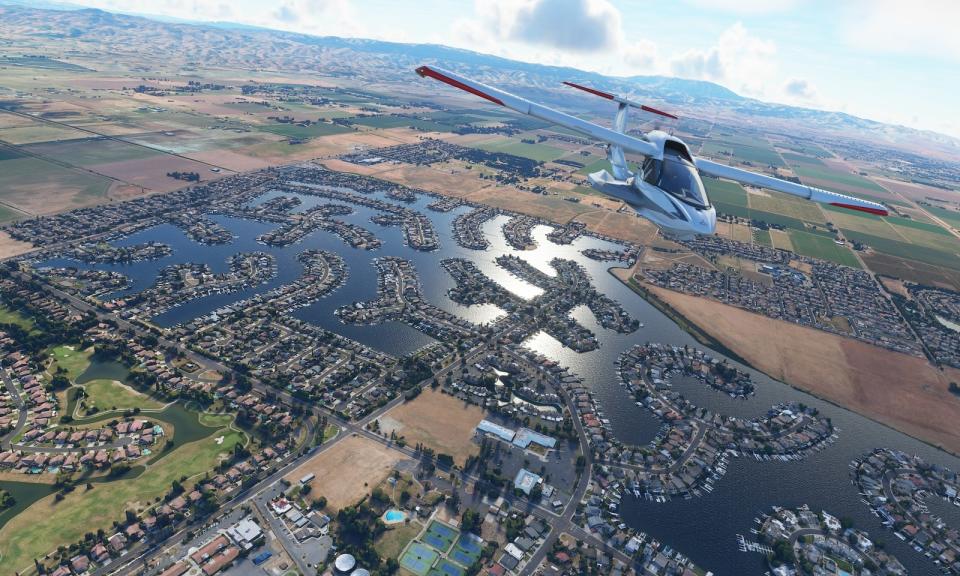
Around me at the Flight Simulator preview event in Seattle, other journalists were checking out their own hometowns, buzzing The Vatican, marveling at Machu Picchu and getting a feel for the geography around the Egyptian pyramids. I crashed my plane into a South Phoenix neighborhood -- landing is by far the most difficult aspect of Flight Simulator -- and booted up a location I'd never visited in real-life: Dubai. Again, I took off, switched to a third-person view, and shifted the environment to my liking. Every trip began with a real-time representation of the actual weather and time in each location, but I wanted to see sunsets and clouds. I set Dubai to rain.
It felt fantastic to learn more about the world in a random flyby.
Even through heavy vapor and moisture, the Burj Khalifa was easy to spot, shooting out of the desert landscape like a shining silver beacon. As I approached, more buildings popped into view. I dropped low along the coast and spotted curious shapes in the water that eventually coalesced into a giant, stylized palm tree. I paused the game briefly and turned to my phone, where I learned this was one of the Palm Islands, a trio of man-made archipelagos hosting hotels and fancy residences. I'd never heard of the islands before, and it felt fantastic to learn more about the world in a random flyby.
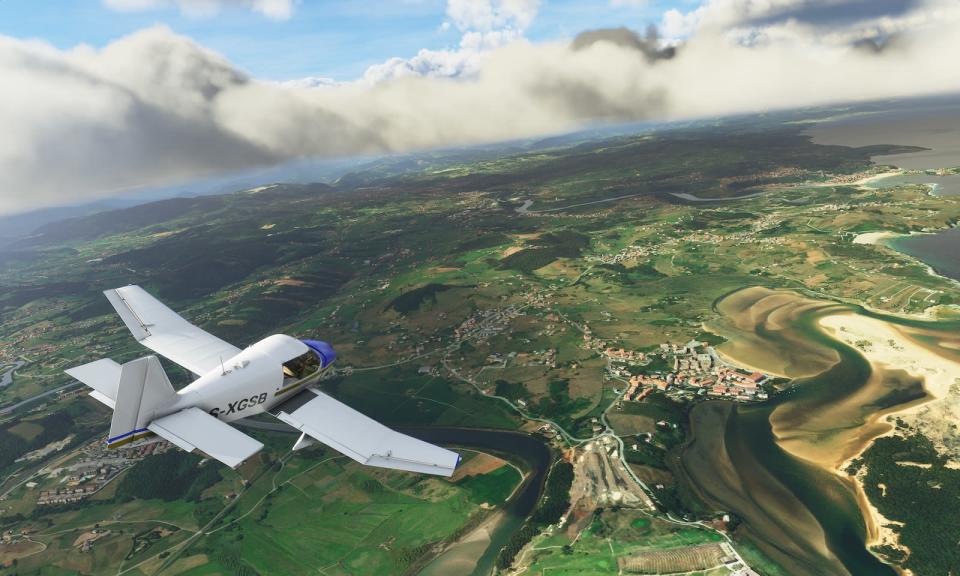
Flight Simulator had that effect on me time and time again. It made the planet feel accessible yet impossibly vast. There was a sense that I could go anywhere in that plane, but once I hit altitude, the immensity of the world set in, and I felt impossibly tiny. Not in a bad way -- simply in a true, realistic sense. You know, like in a simulator.
Bing Maps, but better
The Flight Simulator franchise is Microsoft's longest-running software property. It's older than Windows by three years, with the original title released in 1982. It gets a refresh every few years, taking advantage of evolving computer technology with each launch; the most recent title was Flight Simulator X: Steam Edition, which landed in 2014.
A lot has changed since then.
The rise of online systems has made it possible for developers to recreate the entire planet in the latest Flight Simulator and infuse it with live, real-world events. Every remote island, every landmark and nearly every building is in its proper place, popped into frame in 4K, photorealistic glory via procedural generation and 3D photogrammetry.
That's one reason Asobo Studio is behind this title. It's the home of Fuel, the 2009 open-world racing title that was awarded a Guinness Book world record for having the "largest playable area in a console game," coming in at 5,560 square miles. Today, Asobo's technology is being used to digitize 196.9 million square miles of land, man-made marvels and sea.
Asobo's engine takes full advantage of Microsoft's varied resources, pulling satellite data from Bing Maps and relying on Azure cloud systems to keep the game stable and updated for the majority of players. Machine learning and procedural generation helps populate trees and edifices in the proper spots.
Microsoft is using "other sources" to fill in the gaps in Bing Maps' database, and it's partnered with a handful of third-party companies, including airports and weather-data providers, to pipe live information into Flight Simulator. This means players will be able to see a breakdown of actual flights departing and arriving at any airport on the globe, and experience natural disasters as they happen, from a safe, digital distance.

Just before the preview event in mid-September, Hurricane Dorian hit the Bahamas, traveling slowly and lingering over the islands for days. From their offices in Bellevue, Washington, and Bordeaux, France, Microsoft and Asobo developers flew through the hurricane in Flight Simulator, entering the eye of the storm and getting a sense of the surrounding chaos. Real-world weather systems are growing more extreme under the pressures of climate change, and Flight Simulator will reflect this in real-time, offering a new perspective on dangerous meteorological developments.
Flight Simulator offers a new perspective on the world, period. Developers are committed to holding a mirror to reality, researching and re-creating accurate atmospheres, cockpits, wind patterns, flight maneuvers, weather and locations. Even the stars in the night skies are accurate.
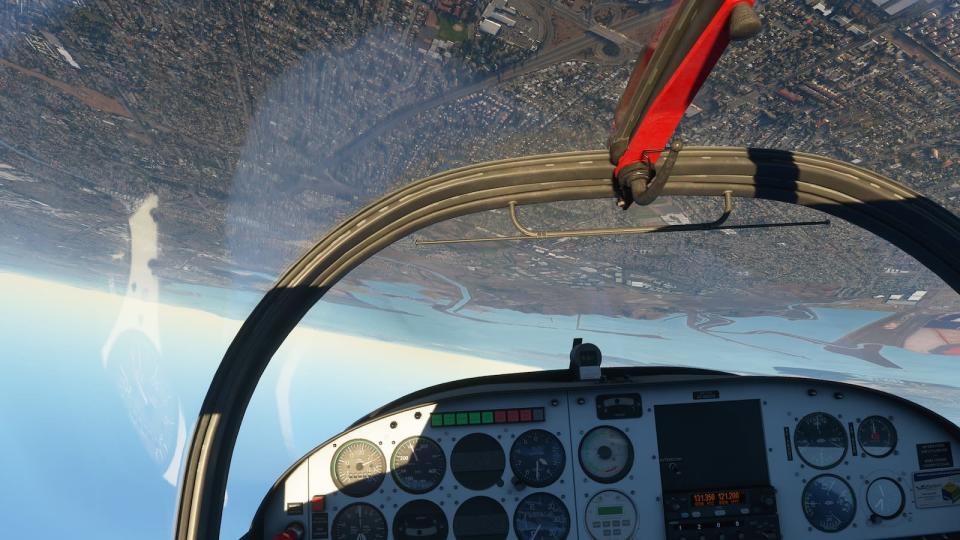
The latest Flight Simulator simultaneously feels like a ridiculously detailed new viewing mode for Bing Maps (or Google Maps, for a reference that more people can relate to), and an intense, realistic training system for wannabe pilots. Because it is such a blank canvas, its applications are vast. It might end up as an educational tool, with teachers sending kids on geographical scavenger hunts; or as an esports title, where players race to complete delivery routes and complicated flight paths. Microsoft is accepting applications for the pre-alpha via the Flight Simulator Insider program, and that's due to kick off this year. The full game -- excuse me, simulator -- will hit PC in 2020, with a launch on Xbox afterward.
Even with the educational, creative and technical possibilities built into Flight Simulator 2019, the scenario I'm most excited for is its use as an everyday decompression tool. The preview alone was an infinitely relaxing experience, requiring just enough attention from me, the pilot, to keep things interesting, while offering up the literal planet as a playground.

